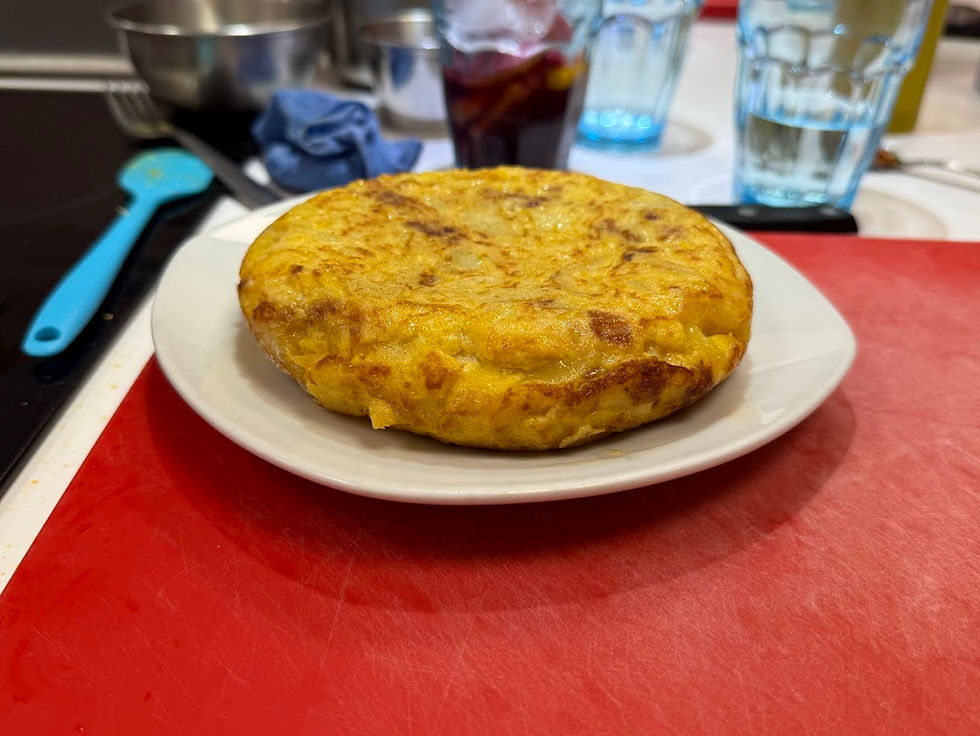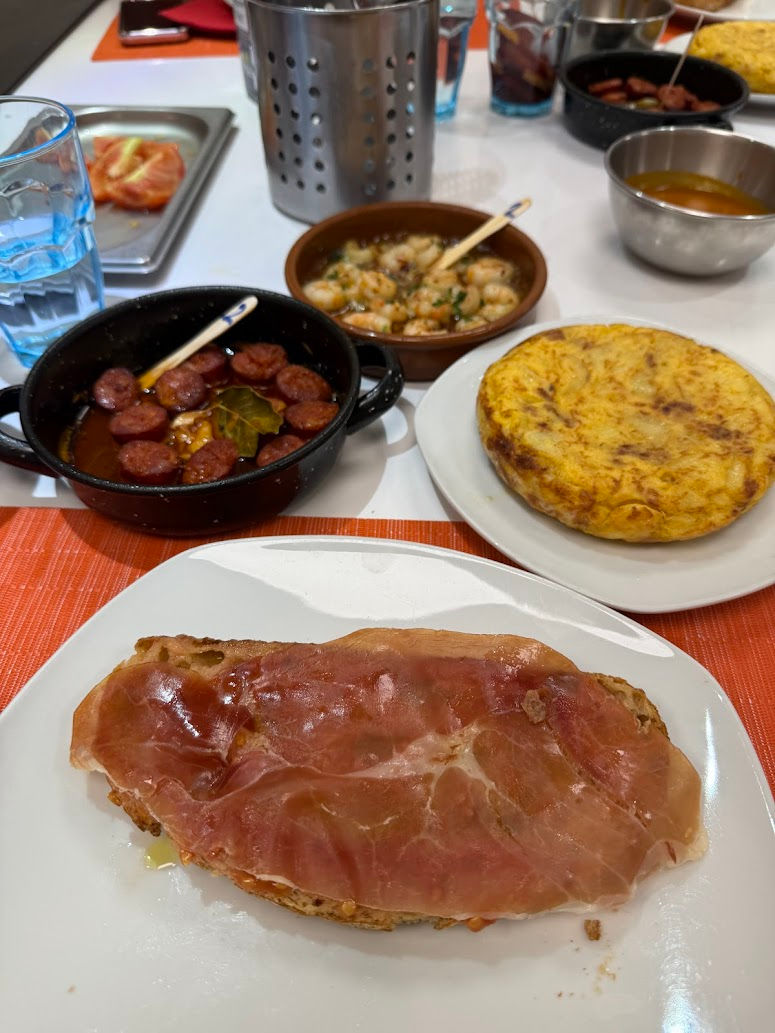Spanish Tapas Cooking Class in Madrid
- seanick9
- Jun 30
- 5 min read
The class: Cooking Point - https://cookingpoint.es/classes-spanish-tapas-madrid-spain
In Madrid, I decided to continue my tour of cooking classes by signing up for a Tapas class! This class was hosted by “Cooking point” in Madrid’s historic center. The teacher was Teresa, a native of Madrid, and there were a few groups visiting from around the world, for a total of 12 students. The group was divided into 6 pairs, each sharing a cooking station.

We started out the class by introductions, saying where we were from and what food we would choose as our last meal, while enjoying some Sangria and making our own for later. Teresa had us put together our menu in an order - things that needed to chill (Sangria, Crema Catalana), things that could stay warm in the oven (Chorizos, Gambas), and the Spanish omelet last so it didn’t dry out, followed by the Patatas Bravas and Pan con Tomate.
Recipes
Sangria
Teresa had us start by putting together a batch of Sangria. This was half a liter of red wine, 2 tbsp sugar, a pinch of cinnamon, orange juice, vermouth and half of each of an orange and lemon. Apparently they use peaches later when they are in season. This was put into the fridge to chill and when served, a bit of soda water was added to give it some fizz.
I’d made sangria before, but didn’t recall having cinnamon in it! The sangria we made in the Paella class I took in Valencia used brandy instead of vermouth. I enjoyed the drier, spiced flavor from these ingredients.
Crema Catalana
After the sangria, we prepared the custard for the dessert. Start by heating 250 ml milk on low in a small pan. Add a couple small peels each of lemon and orange zest, plus a cinnamon stick. In a separate bowl, separate 3 egg yolks (for 2 servings), mixing with sugar and corn starch, whisk until creamy. Strain the infused milk into the egg yolk mixture, mixing while adding to keep it from getting clumpy. Return the blend to the pan and head on medium heat while continuing to whisk it until it gets thick. Pour the mix into two ramekins and refrigerate.
After the main dinner was complete, these were pulled from the fridge, coated lightly in sugar and then brulee’d with a torch. Tasty, it is similar to a creme brulee but was not set- perhaps we didn’t cook the custard enough? Or maybe it’s not supposed to be set like creme brulee. The hints of cinnamon and citrus flavor made for a nice delicate dessert.

Chorizos a la sidra
The Chorizo dish is cooked in small pans. One crushed clove of garlic and two links of Chorizo sliced thick simmer in olive oil until nearly dried out, then they are flipped and some apple cider is added to the pan, along with black peppercorns and a bay leaf. Simmer until the cider is mostly reduced, then move to the oven on low to keep warm.

Gambas Al Ajillo
Many cuisines have shrimp in garlic sauce, and this is the Spanish version. Heat up some olive oil in a pan and add thinly sliced garlic cloves and a dried cayenne pepper. An arbol chile would work, it’s just to add a bit of spice. (Most of the class didn’t notice the cayenne pepper among the garlic as it was quite small, so missed this step. When she realized the mistake was common, Teresa came around with more cayenne peppers to add to the pan. My partner said “hey, can we have a few more?” and we chopped up about 4 cayenne peppers to add to ours - needless to say the end result had quite a kick!) Once the garlic had started to turn golden, we added the shrimp, letting them fry until pink before flipping them over. Add some brandy and reduce a bit, then add some fish stock and simmer a bit more. Once that’s done, season with salt to taste and add to the oven with the Chorizo.

Tortilla de patatas
Otherwise known as a Spanish omelet, the Tortilla de patatas was probably the favorite of the group, both in terms of fun to make and tasty to eat! This started with thin slices of potato, fried until soft but not crunchy. Teresa had some onions that had been simmering for a couple hours which were added to the drained potatoes and some whisked eggs, and then mixed to break up the potatoes and squish them into a flat pancake. Then heat some oil in a small pan and add the mix. The mixture was about the same volume as the pan could hold so it results in a pretty thick, rounded edged omelet. Cook about 5 minutes on medium, using a spatula to separate the mix from the edges of a pan, then use a plate to flip the omelet over. Gently slide the omelet off the plate back into the pan and cook for 5 more minutes. Then set aside to cool.

Patatas bravas
The fries themselves were potatoes cut into large chunks and deep fried, which Teresa did for us. The sauce was our main contribution, and that was more fun. We started with some olive oil and flour to make a roux, then added spices such as paprika, cayenne, and cumin, which were added and gently fried in the roux, before adding some vegetable stock. After the sauce thickens, remove from heat, add a tsp of vinegar and season with salt. Serve the potatoes immediately after frying, covered with the sauce. Yum!
Pan con tomate
Our final step for the Tapas was to make tomato bread. Basically, make some toast then spread the garlic clove and then the tomato directly onto the toast. Since the bread is toasted and warm, the garlic and the tomato both basically just grate on the bread. Then season with olive oil and salt and add a slice of Spanish (Iberico) ham to serve.

We sat around and enjoyed the fruit of our labors along with the Sangria we had made! Overall a fun experience, very hands on, and useful basic recipes and techniques that will be incorporated into my future meals!
Interesting learnings
Paprika came from America, to Spain first, probably from Christopher Columbus 1492 journey - and wasn’t used in Hungary until 1600’s .. I’ve known for a while that regular chili powder (not Paprika or Cayenne) was mostly only available in the Americas, but didn’t realize that even Paprika wasn’t native to Europe.
Bravas sauce starts with a roux (oil and flour) and broth, then just has spices in it, leading to a velvety smooth spicy gravy that you can adjust the heat on easily by just adding more (or less) cayenne.
Making the Pan con Tomate is super quick and takes almost no prep, so there’s no excuse not to just include this in any meal.
Thanks Teresa and Cooking Point, this was a great experience and I really enjoyed it!



Thanks Nick. I hope to enjoy your cooking again someday. 🤞